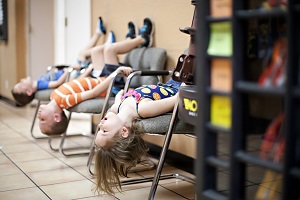No reasonable adult would suggest eliminating the foster care system, or making it impossible for responsible government authorities to remove abused or neglected children from unsafe homes. On the one hand, no one wants to tell parents how to raise their kids. But on the other hand, when the health and well-being of a child is at risk we don’t shrug it off, we intervene. And not indiscriminately or capriciously: about 400,000 children are in foster care at a given moment—a tiny fraction of the nearly 75 million children under 18 in America. Removing children from their parents is a drastic measure and appropriately rare.

“Drastic and rare” is surely what my Fordham Institute colleague Mike Petrilli has in mind in wanting to ensure that no child gets stuck in a hopeless and godforsaken school. Mike and my friend Jason Bedrick, a policy analyst at the Cato Institute, have been exchanging friendly fire over school choice and accountability. Bedrick says choice is accountability. Schools ought to be “directly answerable to the people most affected by their performance,” or parents, not regulators and bureaucrats; I made a similar argument in a US News column in December. Mike agrees, but also wants schools “subject to societal expectations regarding results.” He’d probably agree that we should regulate schools about the same way we regulate parents—lightly and rarely. But in both instances we need to reserve the right to intervene to protect kids in the most extreme cases. That’s just common sense. No one would reasonably object.
And in principle, neither do I. But follow me for a moment on a thought experiment. Those who enter foster care are overwhelmingly from poor homes and disproportionately children of color. Surely there are unsafe upscale homes. Suppose we wished to be more equitable and fair in deciding which children were truly at risk? So what if, instead of leaving it up to the judgment of social workers and others who might be acting on implicit or explicit bias, we decided to identify children potentially at risk largely on measurable data, particularly emergency room visits? If your child ends up in urgent care more often than average, that’s a signal that something might be amiss. You should expect some extra official scrutiny. But rest assured no one’s looking to take your children away. That should worry only the “very worst” parents.
Are you reassured? Or would you make some adjustments to family’s lifestyle and routines? Would you be more inclined or less inclined to let your children play sports? Would outdoor activities like hiking in the woods and playing in the waves at the beach seem a little risky and less appealing? Forget hunting, riding ATVs, using power tools in Dad’s workshop, or that two-week wilderness trip with the Boy Scouts. Maybe it changes your feeling about unsupervised play? Hmm, maybe not; accidents happen. Come to think of it, you might even encourage your children to stay inside more. All it takes is a couple of trips to the emergency room and your family might be at risk of being broken up. Why take a chance? A small but non-trivial risk of being labeled “one of a handful of crappy parents” and having your child removed from your home might have a significant impact on your parenting.
And that’s what I think we’re overlooking. It’s not the three percent of “truly dismal schools” that should concern us. It’s 97% of other schools changing their practices to avoid being perceived as one of those dismal schools that should concern us. It’s curriculum narrowing, over-reliance on test prep, practice exams, and myriad other decisions large and small that cumulatively alter our children’s experience of school—and not always for the better.
No reasonable person objects to the foster care system because, broadly speaking, it seems appropriately focused. Very few of us worry about our children being removed from our homes. By marked contrast, school accountability regimes may be intended to weed out only the “truly dismal,” but they force all schools to demonstrate they aren’t one of those dismal schools. So they begin to behave in ways they otherwise wouldn’t—including adopting instructional practices and school culture habits we might not want.
I visited a school not long ago that is, by all accounts, strong and rapidly improving. My hosts were deeply proud of the school and not without cause. In every classroom I visited, I noticed the same poster encouraging kids to “Keep calm and score basic or above.” I observed a math class where the teacher repeatedly reminded students as they worked to “think about what they want to see.” Several times she asked, “How would you prove it to them?” The “they” and “them” referred to those scoring the state tests, even though they were still many months away. Please don’t blame the teachers or school administrators. They were responding appropriately and sensibly to “societal expectations regarding results.”
I’m morally inclined toward Bedrick’s “choice purist” argument for its simplicity and clarity. I chose my daughter’s (private) school without much official oversight, approval, or fear of sanction. I see no reason to think I’ve cornered the market on sound parental judgment. That said, Petrilli and others who favor stronger oversight are on solid ground when they note that when taxpayers are paying for it, the public has a right, even an obligation, to make sure the money’s not squandered. But where I part company with them is that I’m increasingly open to exploring other forms of accountability, including letting parents vote with their feet.
The bottom line: I’m pro-testing. I’m pro-accountability. It’s test-driven accountability I’m not so sure about. No one wants crappy schools to get a pass. But let’s not overlook the testing tail wagging the schooling dog, or say it’s definitely worth it to identify the worst schools. Maybe it’s time for some new ideas.
— Robert Pondiscio
Robert Pondiscio is senior fellow and vice president for external affairs at the Thomas B. Fordham Institute.


